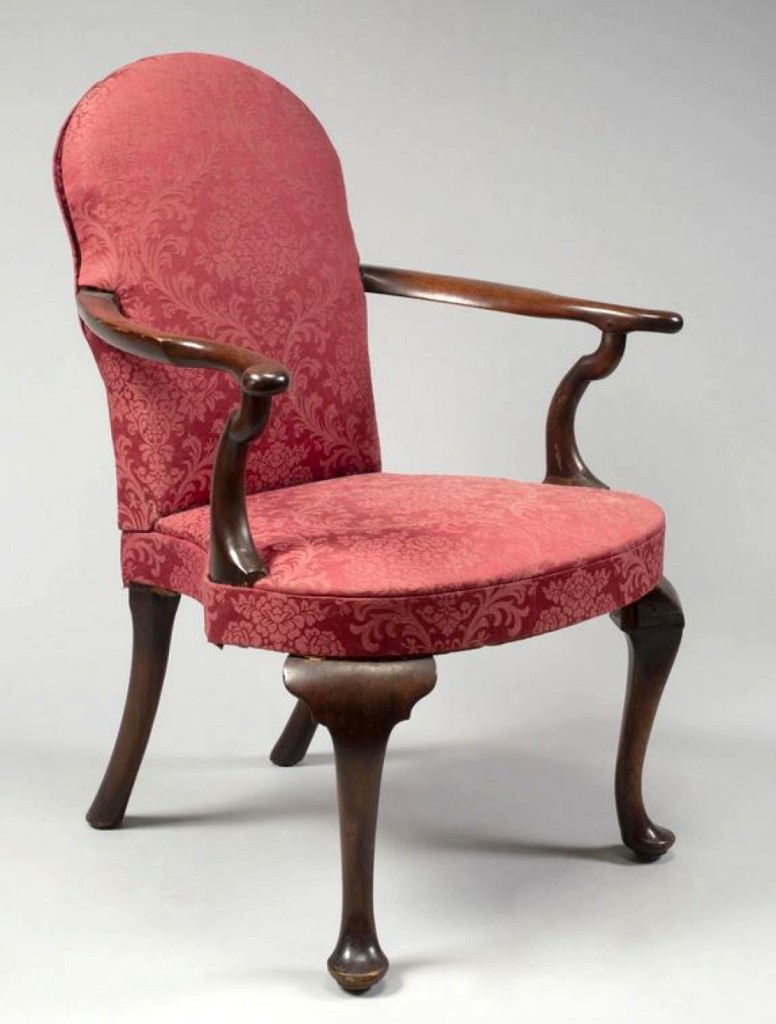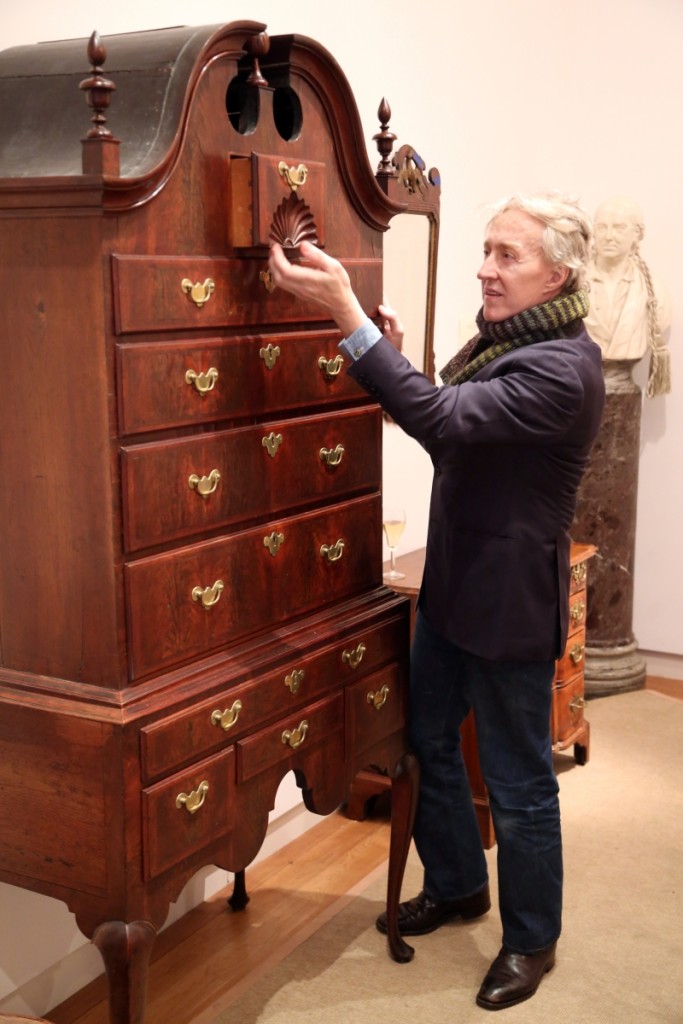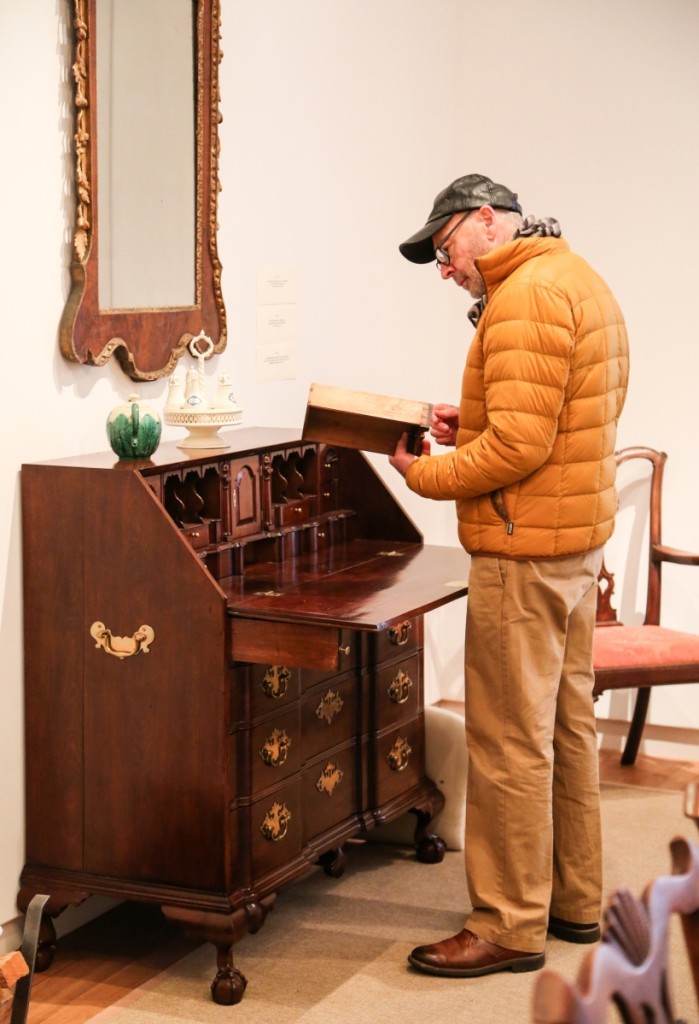
The top lot of the sale was this Queen Anne low back upholstered open armchair that Keno said was likely from New York. It brought above estimate at $87,500. The mahogany chair relates most closely to a pair at the Metropolitan Museum of Art, and another is housed at Winterthur. Keno called it one of the most important mid-Eighteenth Century New York chairs known.
Review and Onsite Photos by Greg Smith, Catalog Photos Courtesy Keno Auctions
NEW YORK CITY – Leigh Keno walked between the three rooms that made up the second floor of his East 69th Street townhouse the day before his January 24 sale as previewers paced about, flipping through the catalog and honing in on their interests. He was answering questions with a phone pressed to his ear in one moment, and in the next he was bent down beside a chest with a flashlight patiently answering questions from a previewer.
Keno’s sale was a boutique offering, 45 lots in the midst of the thousands of others spread throughout Americana Week, but he was excited to be there and to take part in it. The single-owner sale came forth from a New York collection, which Keno had sold into the past. Other lines of provenance on some of the offerings included C.L. Prickett Antiques.
“I am so glad it was the Pricketts,” Keno said before the sale.” I respect their honesty and integrity, they take what they do seriously. And they guarantee everything like I do.”
Keno invited bidding from four platforms on auction day, which began at 3 pm following the Christie’s sale.
“For the furniture, the consignors focused on four criteria, which I discussed with them the first time I met them in 1991, having started my business as a dealer just a few years earlier. On a scale of one to ten, in terms of quality, rarity, condition and provenance, they aimed for a ten in each area,” Keno said. “However, they realized that, in order to create a collection, they had to make a few exceptions. For instance, if the form and quality were great and the piece extremely rare and with its original finish, they would make an exception in terms of a piece not having lengthy provenance. However, the collection had a very high number of pieces which had descended directly from the original owner.”

Auctioneer Leigh Keno examines the deep fan carving on the Samuel Gardner Salem, Mass., Queen Anne bonnet-top high chest of drawers. It went on to sell for $56,250.
The top lot of the auction was found in a Queen Anne low back upholstered open armchair in mahogany that Keno said was likely from New York. It sold for $87,500. Keno sold it into that collection in May of 1991. The characteristics of the chair – upholstered back and seat, distinctive crooked arm-supports, open arms and cabriole legs ending in pad feet – relate it to a small group of known works, two in the collection of the Metropolitan Museum of Art and another at Winterthur.
“This chair, along with the Sir William Johnson side chair, are two of the most important mid-Eighteenth Century New York chairs known and epitomize what this couple loved about American furniture,” Keno said. “Each has a powerful form and is in an excellent state of preservation. Also, each chair retained fragments of its original red cover fabric under rose-head nails.”
The New York Chippendale mahogany compass seat side chair once belonging to Sir William Johnson (1715-1774), Johnstown, N.Y., superintendent of Indian affairs for the northern colonies, took $21,250 postsale. The chair was attributed to the workshop of New York cabinetmaker Thomas Brookman.
A Salem, Mass., Queen Anne bonnet-top high chest of drawers with herringbone borders on crotch veneered drawer fronts, walnut sides, cabriole legs and pad feet would sell after the auction for $56,250. It featured its original batwing brasses and ball finial. It was commissioned by Samuel Gardner.
“Gardner was the wealthiest man in all of Salem,” Keno said. “So it makes sense he would have a high chest of this quality. The way this was made – the veneers and the bookmatched walnut sides – it’s the most expensive thing you could have ordered in 1740. The walnut was imported from Virginia, and it’s just an amazing monument to the Queen Anne style.”
Keno said he underbid the example at a Northeast Auctions sale in 2003 when it sold for $271,250.

A previewer takes a good look at the Chippendale block front desk from Salem, Mass., which went out at $28,125.
A gentleman in the room picked up a Chippendale block front desk from Salem, Mass., for $28,125, near the high estimate. It featured a blocked lid with fitted interior above four drawers with original brasses, a Salem drop-pendant scallop shell centered on the plinth on cabriole legs with claw-and-ball feet.
Also from Salem, Mass., was a mahogany bonnet top chest-on-chest in the Chippendale style, circa 1765 to 1780, that took $18,750. The chest-on-chest was originally owned by John Treadwell and descended in that family until 1991, where it sold at Northeast Auctions to Prickett. Carved pinwheels with urn and flame-carved finials adorned the tympanum above a boldly carved fan on the center top drawer, two drawers fitting the cornice on each side, and eight drawers below with original brasses and escutcheons, four drawers with each chest. To the back of the piece was an old note of provenance, which was transcribed and added to by the owner in 1966, giving it a full provenance history.
An American colonial Chippendale mahogany and tulip-poplar tea caddy on ogee moulding and ogee-bracket feet went well above the $1,800 estimate when it sold for $13,750. The slightly domed lid was carved from a single panel of mahogany.
A Boston Queen Anne mahogany tuckaway tea table with a turned dish top, circa 1750, sold for $22,500 following the sale. The auctioneer said that only six or seven of this type of table are known to survive today. Keno sold this into the collection in 1992, and said, “At the time, Israel Sack Inc had a closely related mahogany tuckaway table from the same shop which they had illustrated in The Israel Sack Collection, Volume 1 and had recently repurchased. My friend and colleague, scholar and conservator Alan Miller kindly assisted me in assessing the condition and also comparing the form and construction of the two tables; we came to the exciting conclusion that they were both from the same (probably) Boston shop.”
The sale also featured bits of decorative lots, including a wool pictorial hooked rug that read “General Washington / Noblest Of Men / His House His Horse His Cherry Tree & Him.” The text indicates exactly what was pictured, with Washington sitting in a star-studded chair to the side. It had sold as part of the Kristina Barbara Johnson in 2014. This time around it brought $6,875. A pair of classical gilt and gessoed white pine eagle wall brackets, circa 1825, took $6,250. A nest of six Nantucket baskets with shaped wooden handles on brass hinges, each with a wood base, sold for $3,750.
Keno had planned for a timed online-only auction curated by Diane and Gary Stradling to follow the sale, but said it had been postponed for a few weeks. It will further include items from this collection, including quality Eighteenth Century English Creamware.
For additional information, www.kenoauctions.com or 212-734-2381.



















